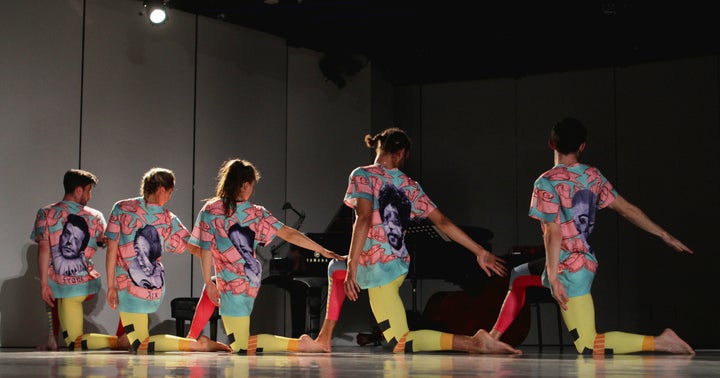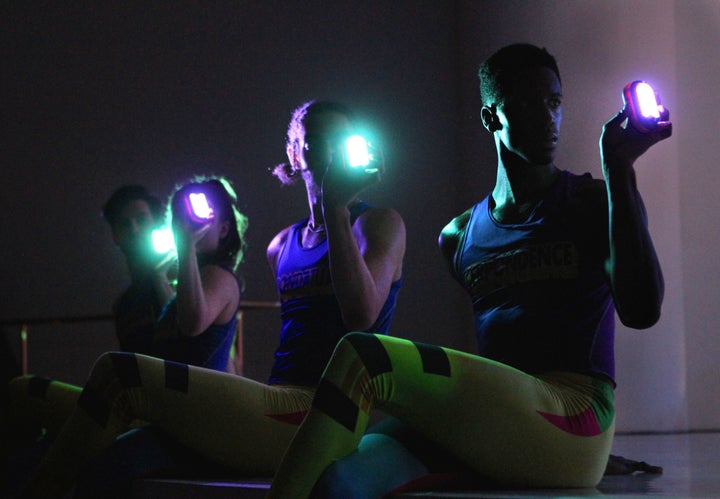
As part of Guggenheim Museum’s Works & Process series, performance artist and collaborative choreographer Ryan McNamara and avant-garde composer John Zorn have created a site-specific performance commissioned for the Peter B. Lewis Theater. Zorn’s composition is entitled Commedia dell’arte and the five pieces (Harlequin, Colombina, Scaramouche, Pulcinella, and Pierrot) reference inspiration from a 16th century Italian form of theater marked by stock character types, though the performance is wholly novel and speaks to our zeitgeist.
In bright costumes straight out of the early nineties (think: neon yellow, orange, and light blue geometric leggings with oversized t-shirts emblazoned with photos of their faces in clown makeup), the performers look like they are off the set of Saved by the Bell if high school were actually a trending Bushwick hot yoga studio. With gentle references to gestures from vogueing and nightclub dance scenes, the movements are faintly recognizable but also escape categorization— they compose the question mark at the end of a half-thought: “Wait, I think I’ve seen that before?”
In the first piece Harlequin, five performers move initially as one organic unit and eventually circle the theater with repetitive gestures as they meet two more performers on stage. They briefly pair off. Half of them tuck themselves under the other’s shirts, creating creatures reminiscent of Plato’s origin story in The Symposium: “humans were originally created with four arms, four legs and a head with two faces.” This leaves one performer alone and partnerless, but the moment is brief and passing. And, unlike Plato’s parable, the rest of the performance does not focus on a sense of yearning or finding one’s other half, but a more nuanced sense of detachment and self-assuredness.

Methodical movements are at times reminiscent of relay races where gestures act as batons. At one point, dancers form a chain, lightly activating the same movement in the next person like a wave in a crowd. At other points, the baton-passing reference is more literal: Water bottles are passed from person to person in a non-urgent manner. Such relaxed chain reactions, at times, hint at themes of self-examination and individuation. In one piece, performers line up, sitting along the edge of the stage, and hold a handheld LED square of light like a cell phone in one hand. They slowly turn and cast the lights onto the person next to them, causing a slow cascade of inquiry, one by one. This repetition is broken when they separate and use their lights to examine their own bodies. In the final piece, performers move to different areas of the theater and reenact the same sequence of movements specific to that location over and over, from station to station.
The use of repetition and relay are mechanical or industrial reference points and hint at the presence of an invisible puppetmaster pulling at the strings of marionettes, trying to make them all dance in the same way. But the casual ease with which the performers execute their movements ultimately suggests a kind of subtle resistance to the idea of being stereotyped or ”jerked around” as stock characters. A lone dancer lurks under the stage, partially hidden at times, and moves in her own way in the shadows. There is collectively a quiet defiance that emerges within this framework of pattern and constraint, which subtly suggests: We are not all the same.
This individuation— the refusal to treated as cloned pawns or stock types— is more overt in the costumes, each clearly marked with their names and faces. Midway through the performance, the performers don tank tops with intriguing words that seem fished from the mind of a mad genius-art curator-natural supplement peddler: vihensity, compontion, subjectual, pondatual, and cerapondence.
Zorn’s music is precise and well-positioned in varying spaces of the theater: vocals from the upper balcony, blaring trumpets from a balcony tucked to the side, a trio of piano, bass, and drums centerstage. The artistry of the musicianship runs rich and deep (Tyshawn Sorey’s drums explode like Pop Rocks in your eardrum, a vocal piece is transcendent and shimmery like fluid mercury, to name a few).

At the end, the dancers remain still and limp, like puppets cut from strings. The musicians and singers arrive on stage to signal the end of the performance and receive their applause. The audience members are free to go but most are clearly reluctant to leave the dancers there, unattended and inanimate. The need to recognize and cherish their efforts is palpable.
McNamara and Zorn’s work escapes broad categorizations or generalizations, a successful amalgam of the familiar and the innovative. Their work is beguiling, cleverly casual, and, at times, deceivingly simple— a sort of hip elegance that isn’t trying too hard but tries in all the right places.
